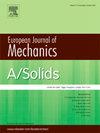一种新型结构力学滑摩连接器的分析与实验研究
IF 4.2
2区 工程技术
Q1 MECHANICS
引用次数: 0
摘要
滑摩连接器广泛应用于结构力学中,通过控制摩擦滑动来提高能量耗散。然而,传统设计通常依靠螺栓预紧力在摩擦界面产生法向力,这导致了预紧力损失、实施复杂性和长期稳定性等问题。为了解决这些限制并提高耗散效率,本研究研究了一种新型滑动摩擦连接器,该连接器通过预压缩弹簧整合弹性恢复力,从而消除了螺栓预紧的需要。通过分析模型分析了该装置的力学特性,并通过实验测试进行了验证。从平衡方程导出的解析公式为力-位移响应提供了一个封闭形式的解,捕获了摩擦滑移和弹性贡献之间的相互作用。进行了循环试验,以评估力学响应,验证模型,并评估耗能能力。结果表明,分析预测和实验数据之间的一致性很强,证实了模型的准确性。研究结果强调了所提出的滑动摩擦连接器作为传统耗散连接的多功能替代方案的潜力,特别是在木结构等建筑应用以及其他需要控制能量耗散的机械系统中。其紧凑的设计和通过调整弹簧刚度来调整响应的能力增强了其在各个领域的适应性。此外,分析模型相对简单,为工程应用提供了实用有效的工具。本文章由计算机程序翻译,如有差异,请以英文原文为准。
Analytical and experimental study of a novel slip-friction connector for structural mechanics
Slip-friction connectors are widely used in structural mechanics to enhance energy dissipation through controlled frictional sliding. However, conventional designs often rely on bolt pretension to generate normal forces at the friction interface, leading to challenges such as preload loss, implementation complexity, and long-term stability issues. To address these limitations and improve dissipation efficiency, this study investigates a novel slip-friction connector that eliminates the need for bolt pretension by integrating an elastic restoring force via a precompressed spring. The mechanics of the proposed device is analyzed through analytical modeling and validated with experimental testing. The analytical formulation, derived from equilibrium equations, provides a closed-form solution for the force–displacement response, capturing the interaction between frictional slip and elastic contributions. Cyclic tests are conducted to evaluate the mechanical response, validate the model, and assess energy dissipation capacity. The results demonstrate strong agreement between analytical predictions and experimental data, confirming the accuracy of the model. The findings highlight the potential of the proposed slip-friction connector as a versatile alternative to conventional dissipative connections, particularly for building applications such as timber structures, as well as other mechanical systems requiring controlled energy dissipation. Its compact design and the ability to tune the response by adjusting the spring stiffness enhance its adaptability across various fields. Moreover, the analytical model, being relatively straightforward, offers a practical and effective tool for engineering applications.
求助全文
通过发布文献求助,成功后即可免费获取论文全文。
去求助
来源期刊
CiteScore
7.00
自引率
7.30%
发文量
275
审稿时长
48 days
期刊介绍:
The European Journal of Mechanics endash; A/Solids continues to publish articles in English in all areas of Solid Mechanics from the physical and mathematical basis to materials engineering, technological applications and methods of modern computational mechanics, both pure and applied research.

 求助内容:
求助内容: 应助结果提醒方式:
应助结果提醒方式:


